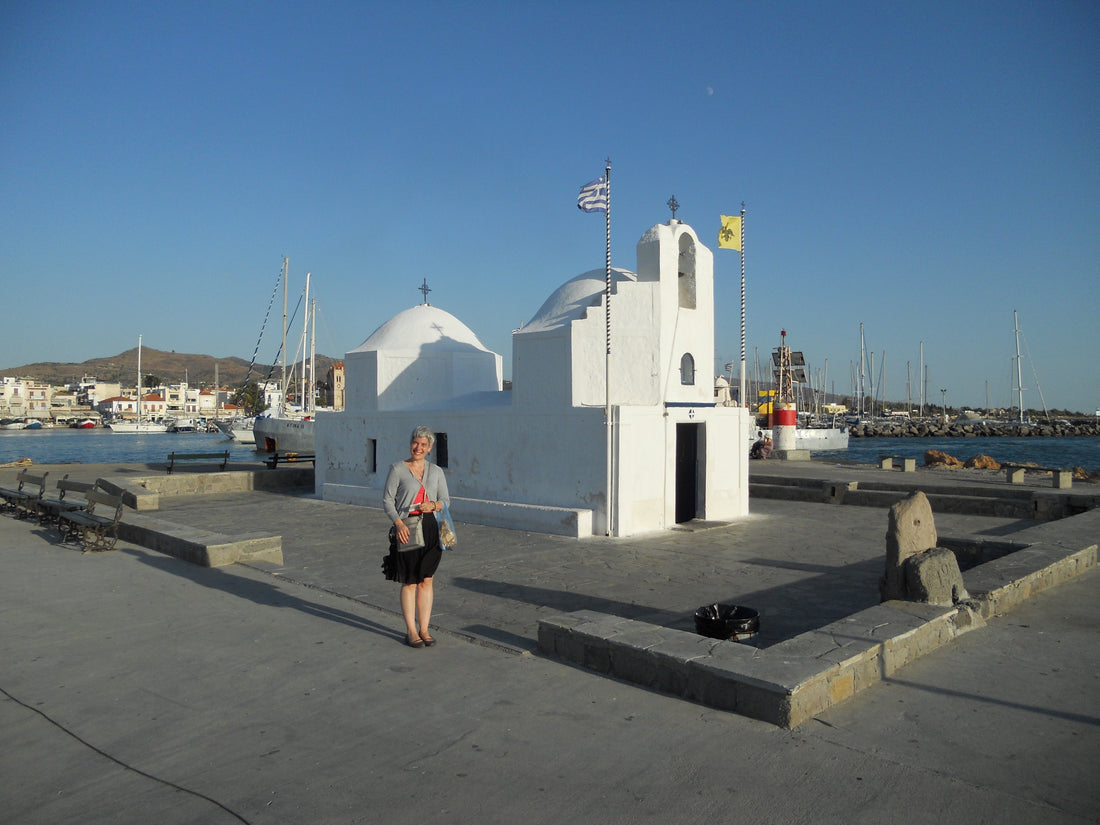
Tips for cross stitch and folk embroidery enthusiasts traveling in Greece
Share
I've had several requests from Avlea stitchers about visiting Greece as a folk embroidery stitcher, so I've coordinated with Rachel Pogois (an Avlea Folk Embroidery stitcher who resides in Athens) and we've come up with the following suggestions. Neither of us consider ourselves "experts", but we do have unique viewpoints. I (Krista) have visited Greece multiple times over the last 20 years to source supplies for my tailoring business, so I've had access to more textile information and experiences than your average tourist. Rachel is American and she and her Greek husband have lived in Athens for over 50 years. We'll keep adding to this post with more info as we have it, so feel free to comment with your own recommendations if you've visited Greece!
Krista: I always travel with a small stitching project that I can show to someone to explain that I know how to stitch (I've often encountered utter shock that an American still does handwork!). This has resulted in some of my favorite interactions in Greece--one time I was visiting the teeny-tiny chapel at the harbor in Aegina while I was waiting for the ferry and I got in a conversation with the two women tending the chapel. As soon as I showed my embroidery, they started enthusiastically showing off the various handmade items. I also keep photos on my phone of my completed pieces that I can whip out if I meet someone who loves embroidery. So, take a little project and photos and be ready to share.
Rachel: My first suggestion to anyone visiting any place in Greece is to find the local museum; even small villages have them. It may be called a Cultural, Folk, or Historical museum. Some seem unimportant because they focus on local products or a historic event, but often there will be displayed an embroidered headscarf, window curtain or traditional dress of that area. They can be real treasures of fiber art and history. Another wonderful way to see embroidery is in traditional houses open to the public. There are quite a few scattered around the country- Patmos, Metsova, Kastoria, Santorini, etc. Some churches of importance and monasteries include museums too.
Every area in Greece is very unique and different from every other area. This is evident in the food, clothing, music, dances, architecture, color and style of fiber art. Be on the lookout for local organizations of traditional dance, craft or handwork. In different areas public holidays are celebrated with programs including food, music, dancing, local customs and traditional clothing.
Unfortunately embroidery is not a art that many young people are interested in learning or using in their homes today. That said, every home has their special pieces made by grandmother, mother, aunt or friend. Depending on the circumstances or relationship if an interest in needle work is expressed drawers and cabinets may be opened revealing wonderful pieces.
The Monastery of St. John, the Apostle; Patmos
The Basil Papantoniou Foundation (former Peloponnesian Folklore Foundation); Nafplion, www.pli.gr/en
Megaron Gyzi; Thira, Santorini, www.gyzimegaron.gr

Some additional places to visit if you're interested in seeing folk costume/folk museums:
--Perachora, Greece (about an hour west of Athens)--small village museum with about 20 folk costumes and beautiful displays of the community's heirloom embroideries and textiles
--Nafplio, Greece--the Folklore Museum of the Peloponese--a wonderful museum with a vibrant collection of about 30 folk costumes plus other items
--Kalamata, Greece--the Victoria Karelias Folk Costume Collection--a stunning collection of over 100 folk costumes, displayed in a beautiful and elegant setting. Completly worth making the trip to Kalamata just to see this museum (but you can also enjoy the seaside and the wonderful tavernas in the old section of the city)
--Arachova, Greece--about 2-1/2 hours northwest of Athens (15 minutes south of Delphi) small village folk museum with about a dozen folk costumes and some excellent weaving examples
--Chrisso, Greece--small village folk museum about 20 minutes beyond Arachova (about 10 minutes beyond Delphi) which houses an impressive 60+ folk costume collection well worth visiting!
--National Hellenic Museum, Athens--about a 15 minute walk from the Plaka/Acropolis area, this collection houses some lovely folk costumes (and has those cute folk costume bookmarks!). If you're in Athens and want to get a taste of folk costume, this is a great place to start!
